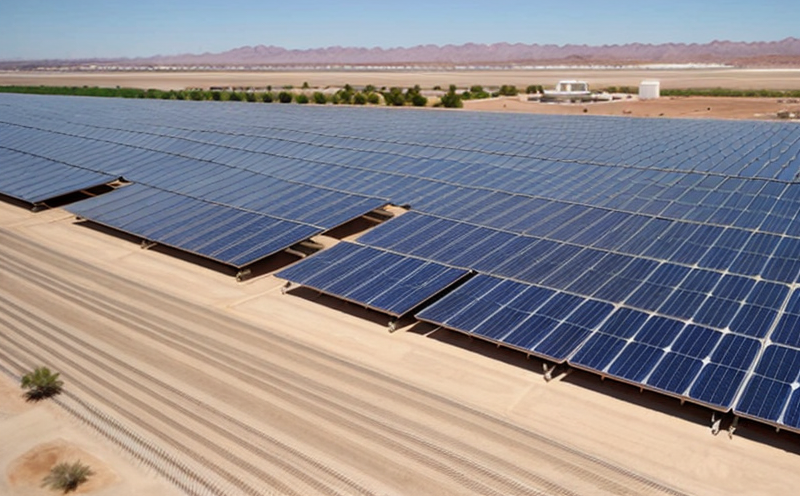EN ISO 9806 Collector External Condensation Testing
The EN ISO 9806 standard is a crucial benchmark for testing solar thermal collectors, particularly focusing on the external condensation resistance of these systems. This test ensures that collectors can withstand environmental conditions without compromising performance or safety. Understanding how this test impacts various aspects of renewable energy technology and compliance requirements is essential for quality managers, procurement officers, and R&D engineers.
Collectors used in solar thermal applications often operate under harsh outdoor conditions where condensation may form on the collector surface. The formation of condensation can lead to reduced efficiency, potential damage to the collector's structural integrity, or even safety hazards. The EN ISO 9806 test provides a standardized method for evaluating and certifying collectors based on their resistance to external condensation.
The standard defines specific procedures and acceptance criteria that must be met by solar thermal collectors to achieve compliance. It covers various aspects such as the design of the collector, materials used, manufacturing processes, and installation practices. Compliance with these standards helps ensure product reliability, safety, and performance in diverse environmental conditions.
The testing procedure involves exposing a sample collector to controlled environmental conditions that simulate real-world scenarios where condensation might occur. The test evaluates how effectively the collector resists the formation of condensation on its external surfaces. This includes assessing factors like thermal insulation properties, material composition, and surface finish.
One of the key aspects of this testing is understanding the environmental conditions that can lead to condensation. Factors such as temperature differences between the internal and external parts of the collector, humidity levels in the surrounding air, wind speed, and solar radiation play significant roles. By simulating these conditions accurately, the test provides valuable insights into how well a particular collector design performs under potential adverse weather situations.
The results from this testing are critical for manufacturers as they help identify areas where improvements can be made to enhance the condensation resistance of their products. For instance, changes in insulation materials or modifications to the collector's geometry could result in better performance during periods when condensation is likely to form. Additionally, these tests serve as a means to ensure uniformity across different batches of manufactured collectors, thereby maintaining consistent quality standards.
For procurement officers and R&D engineers involved in selecting suppliers or developing new technologies related to solar thermal energy systems, compliance with the EN ISO 9806 standard offers peace of mind regarding product performance and longevity. It also facilitates smoother regulatory processes by providing clear guidelines on what constitutes acceptable levels of condensation resistance.
- Testing helps in identifying potential issues early in the manufacturing process;
- It supports continuous improvement efforts aimed at enhancing overall product quality;
- Compliance ensures adherence to international standards, which is increasingly important as global markets continue to expand.
Applied Standards
The EN ISO 9806 standard provides detailed procedures for testing solar thermal collectors regarding their external condensation resistance. This includes specific requirements concerning specimen preparation, environmental chamber setup, and measurement techniques used during the test.
For instance, specimens must be prepared according to strict guidelines outlined in the standard before they can undergo testing. These preparations typically involve cleaning the surface of the collector thoroughly and ensuring it remains free from any contaminants that might affect the outcome of the test.
The environmental chamber used for this type of testing needs to meet certain specifications regarding temperature control, humidity levels, and airflow rates. The purpose is to create an environment closely resembling actual field conditions where condensation could form on a collector's external surface.
During the test itself, various measurements are taken at different intervals throughout its duration. These include monitoring changes in surface temperature of the collector, measuring the amount of condensate formed on it, and assessing any impact these factors have on overall system performance.
Why Choose This Test
Selecting EN ISO 9806 Collector External Condensation Testing is advantageous for several reasons. Firstly, it ensures that your solar thermal collector meets internationally recognized standards, which enhances its credibility in both domestic and international markets.
Secondly, this testing provides valuable feedback on how well a particular design performs under potentially challenging conditions. Such insights are invaluable when making decisions about future product development or sourcing new suppliers.
Thirdly, compliance with these standards simplifies the process of obtaining necessary approvals and certifications required by various regulatory bodies worldwide. This can significantly reduce time-to-market for new products while also minimizing associated risks.
In addition to these benefits, choosing EN ISO 9806 Collector External Condensation Testing allows you to demonstrate commitment to quality assurance practices within your organization. It reflects an ongoing effort towards excellence and reliability that is highly regarded by customers, partners, and stakeholders alike.
Environmental and Sustainability Contributions
- The testing promotes sustainable manufacturing practices by encouraging manufacturers to use more efficient materials and processes;
- It supports the development of more durable products that last longer, thereby reducing waste generation and resource consumption over time;
- Compliance contributes to minimizing environmental impact through improved energy efficiency in solar thermal systems.





